Xylophanes aristor
|
|
Updated as per personal communication with Les Catchick (Baeza, Napo, Ecuador, April 5, 2011); December 7, 2011
Updated as per personal communication with Jose Ramon Alvarez Corral (El Valle, Merida, Venezuela, 80mm, 2050m, March 2, 1993); July 21, 2012
|
Xylophanes aristor
zail-AH-fan-eesM
uh-RIHS-tor or
zye-LAH-fan-eesM
uh-RIHS-tor
(Boisduval, 1870), Choerocampa
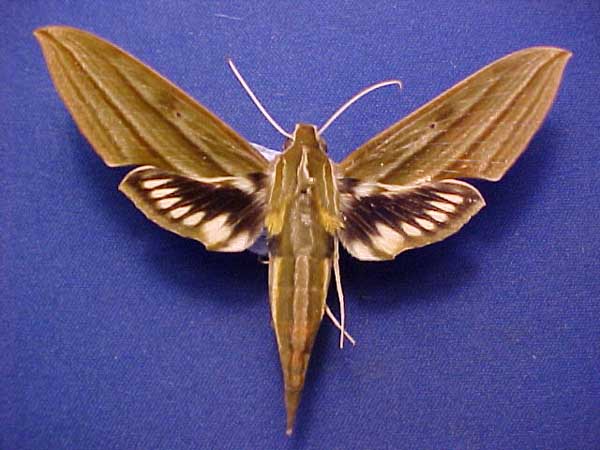
Xylophanes aristor courtesy of John Vriesi.
This site has been created by
Bill Oehlke at oehlkew@islandtelecom.com
Comments, suggestions and/or additional information are welcomed by Bill.
TAXONOMY:
Family: Sphingidae, Latreille, 1802
Subfamily: Macroglossinae, Harris, 1839
Tribe: Macroglossini, Harris, 1839
Genus: Xylophanes Hubner [1819] ...........
Species: aristor (Boisduval, 1870)
|
MIDI MUSIC
.....It's a Wonderful World.....
copyright C. Odenkirk
ON.OFF
<bgsound src="world.mid" LOOP=FOREVER>
|
DISTRIBUTION:
Xylophanes aristor moths
[wingspan 80mm, females larger than males]
fly from
Guatemala, (specimen type locality); to
Venezuela: Merida: El Valle; and
Ecuador: Napo: Baeza (LC); and
probably Colombia.
"Similar to Xylophanes crotonis but immediately distinguishable by the broad grey dorsal stripe on the thorax and abdomen.
Most similar to Xylophanes kiefferi but less robust and outer edge of forewing more convex.
"Differs from Xylophanes crotonis in thorax and abdomen having a broad, grey, dorsal stripe, which is often divided medially by a narrow brown line, and from
Xylophanes kiefferi in the olive-green (rather than deep rich brown) upperside of the body. Tegula edged in grey along both its inner (dorsal) and outer
(lateral) margins; no median line of grey scales.
Forewing upperside similar to Xylophanes kiefferi but ground colour olive-green (rather than deep rich brown) and first and fourth postmedian lines
closer together. " CATE
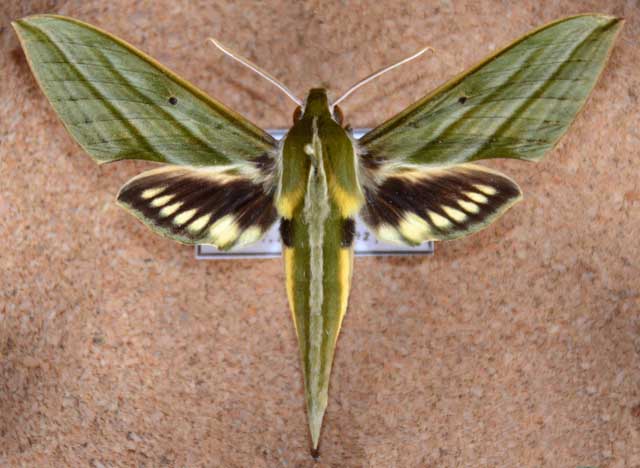
Xylophanes aristor, 80mm, El Valle, Merida, Venezuela,
February 2, 1993, 2050m, courtesy of Jose Ramon Alvarez Corral.
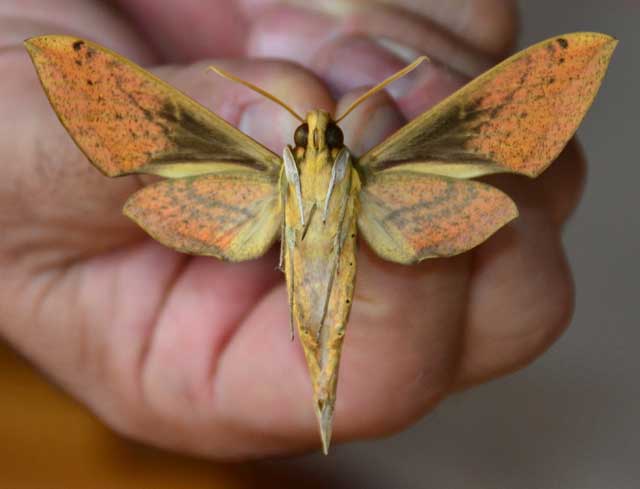
Xylophanes aristor, 80mm, verso, El Valle, Merida, Venezuela,
February 2, 1993, 2050m, courtesy of Jose Ramon Alvarez Corral.
"Forewing underside similar to Xylophanes kiefferi but orange; basal area black and more extensive, so that first postmedian line merges with it around the
level of M3; second postmedian line lighter, less sinuate and often comprising a series of discontinuous spots, merging with the dark basal area before CuA2;
dark marginal area farther from postmedian area, not reaching the third one (represented by vein dots), dirty grey with a scattering of black scales,
very distinct from the ground colour of the rest of the wing and delineated by a grey line that is toothed on M2; apical area, between costa and Rs4 beyond
most distal costal dark spot, longer, paler yellow.
Anal area of hindwing underside whitish (bright yellow in Xylophanes kiefferi)." CATE
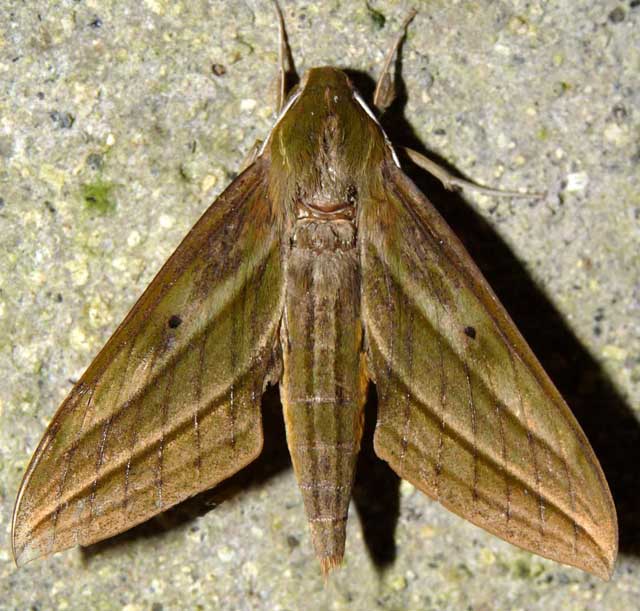
Xylophanes aristor, Bellavista Lodge (00 00 58 S., 078 40 53 W., 2270m), Pichincha, Ecuador,
June 6, 2010, courtesy of Gerard Boulay, tentative id and slight digital repair by Bill Oehlke.
FLIGHT TIMES:
Xylophanes aristor probably broods
continuously.
Les catchick reports an April flight in Baeza, Napo, Ecuador.
Jose Ramon Alvarez Corral reports an early February flight in El Valle, Merida, Venezuela.
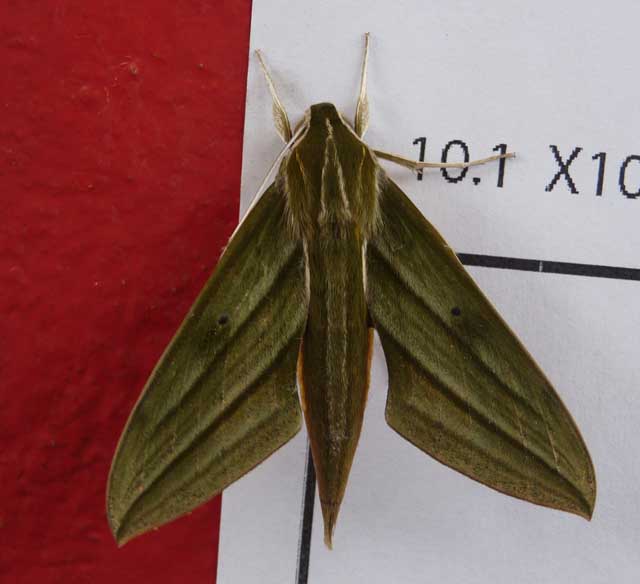
Xylophanes aristor, Baeza, Napo, Ecuador,
April 5, 2011, courtesy of Les Catchick
ECLOSION:
Pupae probably wiggle to surface from
subterrqnean chambers just prior to eclosion.
SCENTING AND MATING:Females call in the males with a pheromone released from a gland at the tip of the
abdomen. Males come in to lights very readily, but females are seldom taken in that way.
EGGS, LARVAE, PUPAE:
Larvae probably feed on Psychotria panamensis and Psychotria nervosa
of the Rubiaceae family and on
Pavonia guanacastensis of the Malvaceae family.
Moths emerge approximately one-two months after larvae pupate.
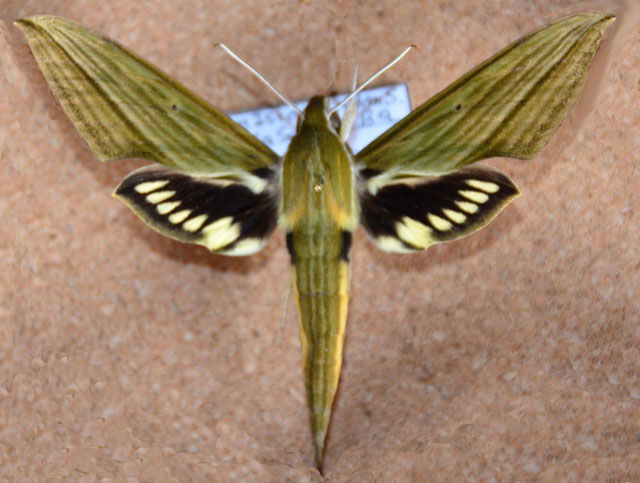
Xylophanes 1A, 85mm, La Soledad, Barinas, Venezuela,
September 10, 1997, 1400m, courtesy of Jose Ramon Alvarez Corral,
tentative id by Bill Oehlke, might be something undescribed.
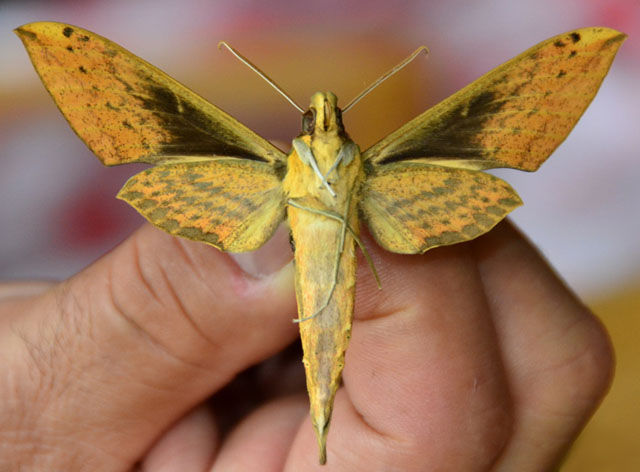
Xylophanes 1B, 85mm, La Soledad, Barinas, Venezuela,
September 10, 1997, 1400m, courtesy of Jose Ramon Alvarez Corral,
tentative id by Bill Oehlke, might be something undescribed.
The pronunciation of scientific names is
troublesome for many. The "suggestion" at the top of the page is
merely a suggestion. It is based on commonly
accepted English pronunciation of Greek names and/or some
fairly well accepted "rules" for latinized scientific names.
The suggested pronunciations, on this page and on other pages,
are primarily put forward to assist those who hear with internal
ears as they read.
There are many collectors from different countries whose
intonations and accents would be different.
Jean Marie Cadiou writes, "When I say "Xylophanes" in English I
pronounce it something like "Zailophanees", with the emphasis on the
"o". The French pronounce it differently, something like
"Kzeelophaness" with no emphasis, and the Germans yet in a
different way..."
In Greek myth, Phanes is the golden winged Primordial Being who
was hatched from the shining Cosmic Egg that was the source of the
universe. He personifies light emerging from chaos.
"Xylo" is the Greek word for wood.
The specimen type for the genus
Xylophanes is Xylophanes anubus. Perhaps ? when Hubner
examined this species, the yellow-orange and brown tones of the
forewings suggested wings of wood.
The species name "aristor" probably comes
from Greek-Roman mythology.
Use your browser "Back" button to return to the previous page.
Goto Main Sphingidae Index
Goto Macroglossini Tribe
Goto Central American Indices
Goto Carribean Islands
Goto South American Indices
Goto U.S.A. tables






